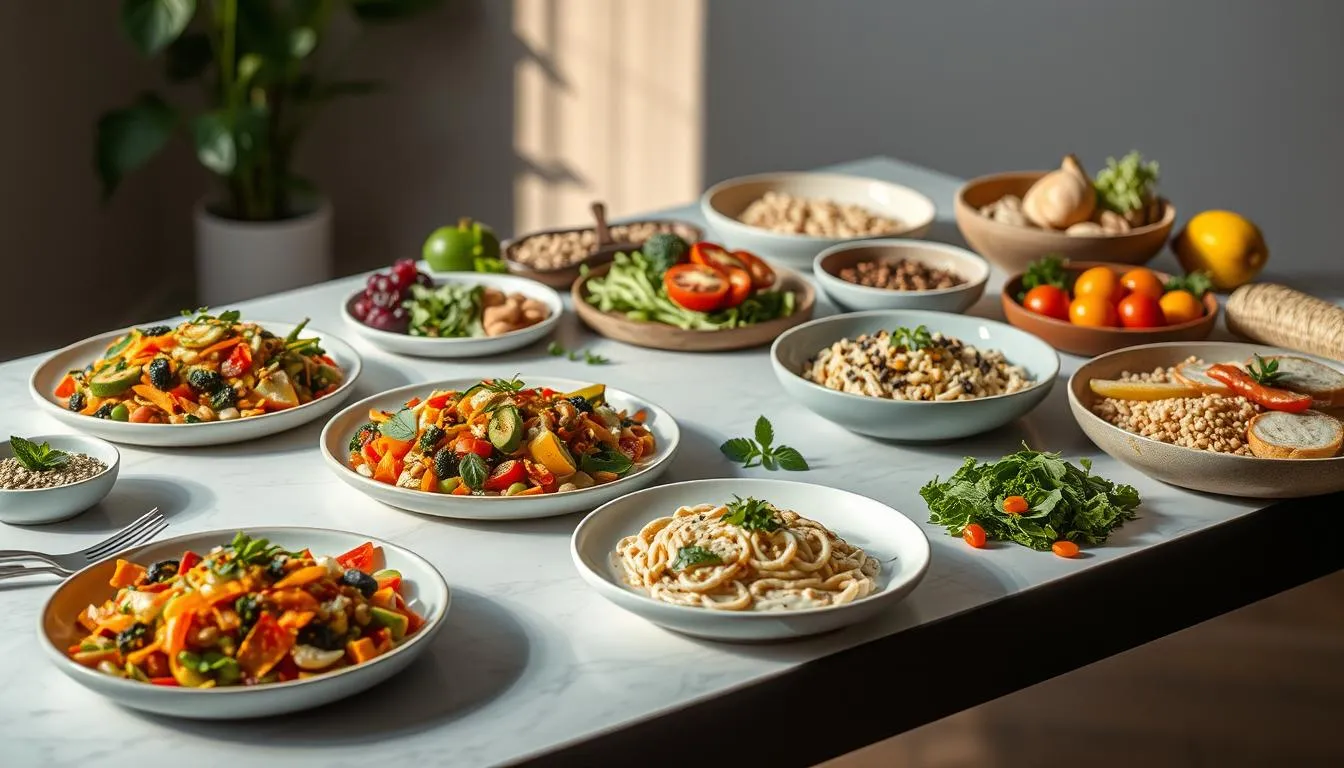I still remember the first time a familiar recipe surprised me same comfort, new source and that feeling stuck with me. The U.S. market has moved fast from niche experiments to everyday choices. Today, clear value and better taste help shoppers switch without compromise.
This short report maps key market signals, consumer trends, and the tech that makes modern food sing. Companies pair texture and flavor science to match what people already love. That progress drives more shelf launches and wider foodservice adoption.
Expect practical, data-driven insight on demand, regulation, and scale up. We highlight sustainability benefits, sensory leadership, and go-to-market moves that matter now. For a deeper look at how the sector is evolving, see this overview on quality and progress: the future of plant-based innovation.
Key Takeaways
- What was niche is now mainstream in the U.S., driven by clearer value for everyday eaters.
- Flavor and texture advances are crucial to repeat purchases across core categories.
- Investment, policy support, and R&D are speeding product development and launches.
- Sustainability benefitslower emissions and resource useresonate with consumers.
- The most successful approaches blend tech, culinary design, and consumer insight.
PlantBased Innovation at Present: Market Signals, Consumers, and Category Momentum
Todays shelves reflect a clear shift: more everyday shoppers choose alternatives that fit familiar meals. Nearly half of U.S. adults follow dietary principles: 26% identify as flexitarian or meat-reducing, 17% as vegetarian, and 6% as vegan. This mix validates broader assortment strategies that target repeat buyers.
Global launch activity is a clear signal. Asia led with an +85% CAGR in launches (20182022), followed by MEA (+62%) and LATAM (+55%). These hotspots preview flavors, formats, and price moves that often arrive in the U.S. market later.

Shifting consumer choices
When people replace meat directly, 29% pick vegetables first and 21% pick legumes. That shows opportunity for standalone, plant-forward meals rather than only direct meat substitutes.
Growth pockets and product focus
Poultry substitutes grew fastest (+96% CAGR), suggesting companies expand beyond burger-style products into new categories like ready meals and sauces.
| Signal | Data Point | Implication | Action |
|---|---|---|---|
| Consumer mix | 26% flexitarian; 17% vegetarian; 6% vegan | Mainstream demand | Broaden assortment |
| Launch hotspots | Asia +85% CAGR; MEA +62%; LATAM +55% | Flavor & format cues | Pilot regional flavors |
| Subcategory growth | Poultry substitutes +96% CAGR | Category whitespace | Invest in poultry/seafood analogs |
| Taste feedback | 44% want improved flavor | Taste drives repeat | Partner with flavor houses |
- Retail and foodservice penetration normalizes choices and drives trial.
- Pricing toward everyday value helps capture flexitarian baskets.
- Segment messaging by health, ethics, or sustainability to match consumer motivations.
For retail trends and sales context, see the 2022 retail sales data report.
Technologies Powering the Next Wave: From Extrusion to Precision Fermentation
Several manufacturing advances now let developers match texture, juiciness, and flavor at scale.
Highmoisture extrusion remains the backbone process for fibrous meat and seafood analogs. It delivers consistent bite and chew across burgers, nuggets, and seafoodstyle products at industrial throughput.
Ohmic heating uses alternating current for rapid, uniform heat. That improves emulsification, gelation, and foaming while reducing antinutrients and preserving sensory quality versus some chemical treatments.

Shearcell and electrospinning
Shearcell structuring, including Couette designs, yields controlled deformation for wholecut textures. Rival Foods and The Vegetarian Butcher use it to make stable, juicy analogs.
Electrospinning creates nanoscale scaffolds from proteins or polymers. Meatable and VIVOLTA are developing nonanimal electrospun materials that mimic muscle fibers.
3D printing, fermentation, and microalgae
3D printing customizes shapes and layered textures; Revo Foods, Redefine Meat, and SeaSpire are pushing scale. Precision fermentation supplies heme and dairyidentical proteins to boost umami and creaminess.
Microalgae grown in bioreactors expands the ingredients toolkit with dense, functional protein and cleanlabel claims.
| Technology | Main benefit | Use case | Notable companies |
|---|---|---|---|
| Highmoisture extrusion | Fibrous texture at scale | Burgers, nuggets, seafood analogs | Multiple manufacturers |
| Ohmic heating | Uniform heating; better protein functionality | Emulsions, gels, reduced antinutrients | Food processors |
| Shearcell / Electrospinning | Wholecut texture; scaffolds | Steak analogs; muscle fibers | Rival Foods; The Vegetarian Butcher; Meatable/VIVOLTA |
| 3D printing / Fermentation / Algae | Customization; flavor precursors; protein density | Custom steaks; heme/dairy analogs; protein ingredients | Revo Foods; Redefine Meat; SeaSpire |
- Hybrid approaches often blend these technologies to match target formats and sensory goals.
- Align R&D roadmaps to costinuse and scale to turn pilot successes into commercial products.
Taste Wins: Flavor, Aroma, and the Sensory Science Behind Consumer Adoption
Flavor quality is the gatekeeper: shoppers keep what truly tastes like the real thing.
Consumers expect familiar taste, aroma, and mouthfeel. When a product nails those cues, repeat purchases rise. That makes taste non-negotiable for mainstream success.

Precision fermentation and dairy/heme boosts
Precision fermentation supplies dairy proteins and heme that deepen umami and add creaminess. Companies like Perfect Day and Impossible Foods use these tools to lift burgers, cheeses, and beverages toward animal benchmarks.
Partnering with flavor houses
Aroma drives perception and memory. Flavor specialists such as Aromatech craft authentic meat and dairy notes while navigating labeling and regulatory needs.
- Iterative optimization: balance salt, fat, and umami to create craveable profiles.
- Masking off-notes: targeted aromas and thermal choices reduce beany or astringent cues.
- Localized profiles: smoke, herbs, and spice blends tune products for U.S. regions.
- Integrated formulation: fat systems, binders, and flavor delivery ensure consistent results across grilling and air-frying.
When flavor leads, consumers pay fair prices and explore new alternatives. Rapid prototyping with flavor partners speeds time to shelf while preserving clean-label claims when possible.
Sustainability and Benefits Driving Adoption in Foods and Beverages
Shifting what we eat can cut emissions, save water, and protect land in ways people can see and feel.
Climate and water wins are measurable. Animal agriculture causes roughly 14.5% of global greenhouse gas emissions. A plant-based burger can produce about 90% fewer emissions than a beef burger. That scale matters when restaurants and retailers swap menu items or SKUs.
Water use highlights the efficiency story. Beef needs roughly 1,800 gallons per pound versus about 216 gallons per pound for soy. Those numbers help consumers and operators picture savings at the meal level.
Cleaner processing and lower residues
Physical methods like ohmic heating use less input and leave fewer residues than some chemical treatments. That supports clean-label goals while lowering energy and water needs in production.
Operational and environmental impacts
Shifting to these foods reduces land demand and pollution from fertilizers and animal waste. That protects biodiversity and improves watershed health near farms.
| Area | Metric | Impact |
|---|---|---|
| Emissions | Animal ag ~14.5% global GHG | Replacing meat and dairy meals cuts CO2e; some burgers ~90% lower |
| Water | Beef ~1,800 gal/lb; Soy ~216 gal/lb | Major per-meal savings for operators and consumers |
| Land & Pollution | Less land use; lower fertilizer runoff | Preserves habitat and reduces watershed impacts |
| Processing | Ohmic heating & physical treatments | Fewer residues, cleaner labels, stable costs |
Practical takeaway: environmental benefits support margins, resilience, and loyaltybut taste and nutrition must lead. Brands should state simple impact metrics (emissions, water, land) and validate claims with partners to avoid greenwashing.
PlantBased Innovation: U.S. Market Opportunities, Companies, and GotoMarket Paths
Actionable routes to market hinge on taste leaders, smart partnerships, and scalable processes that protect quality.
Consumer preferences put flavor first, then nutrition and price. Brands should write briefs that prioritize taste and use flavor partners like Aromatech to close sensory gaps. When products deliver on aroma and mouthfeel, repeat rates climb and trial converts to loyalty.
Category whitespace centers on poultry substitutes (+96% CAGR, 20182022), compelling seafood analogs, and convenient ready meals for weekday dinners. Companies such as Rival Foods (shearcell) and Revo Foods (3D printing) show how structural tech meets format demand.
Scaling from pilot to production requires clear development plans. Validate throughput, yield, and sensory consistency early. Leverage precision fermentation inputs (heme and dairy proteins) to boost umami and cooking performance. Line up regulatory and labeling strategies before retail onboarding to reduce surprises.
- Prioritize flavor in positioning and briefs.
- Target poultry, seafood, and ready meals for fastest growth.
- Partner with structural tech and flavor houses to speed product development.
- Use research sprints and pilot runs to derisk costs and ingredient supply.
- Customize SKUs by channel to widen trial and repeat purchases.
Conclusion
The category now sits at a real inflection point where taste, cost, and nutrition meet in everyday meals.
Technology and culinary craft are working together from extrusion and shear-cell to precision fermentation to make products that cook, smell, and feel familiar. That mix shortens the gap between novelty and repeat purchase.
Global launch momentum, especially in Asia, MEA, and LATAM, offers format and flavor cues to adapt for U.S. shoppers. Measurable sustainability wins on emissions, water, and land remain a strong business case.
Keep investing in R&D, flavor partnerships, and scaled processes. Focus on clear labels, better protein quality, and delicious meals to reduce switching friction and grow the market for plant-based food options.
FAQ
What is driving the shift from niche alternatives to mainstream choices in the U.S. market?
Consumers are choosing more flexible diets, with many identifying as flexitarians who want lowerimpact options without sacrificing taste. Retail availability, improved textures from highmoisture extrusion and shearcell structuring, and better flavor work from flavor houses have all helped move these products into everyday shopping carts.
Where are the global launch hotspots and why do they matter for U.S. brands?
Europe and parts of Asia show rapid newproduct activity, especially in seafood analogs and ready meals. Those markets reveal what consumers accept first like format and flavor and provide valuable lessons for U.S. rollouts, including supply chain models and regulatory approaches such as approvals for precision fermentation ingredients.
Are companies still focusing on direct meat swaps or new standalone formats?
Both. Many makers began with swaps to win familiarity, but interest now grows in standalone offerings that celebrate unique textures and flavors. This opens category whitespace for items like plant protein bowls, seafood analogs, and meatless ready meals tailored to modern eating habits.
How does highmoisture extrusion improve texture in meat alternatives?
Highmoisture extrusion aligns protein and fiber networks to create a juicier, meatlike bite. It enables wholecut textures at scale, helping products better match consumer expectations for mouthfeel and appearance without relying on heavy additives.
What role do techniques like electrospinning and 3D printing play?
Electrospinning and scaffolding create authentic fiber structures for wholecut analogs, while 3D printing enables customized textures, shapes, and precise protein placement. Together they expand possibilities for premium products and niche applications like personalized nutrition.
How are alternative proteins such as microalgae being used?
Microalgae and other novel proteins offer concentrated nutrients, functional emulsification, and distinct flavor profiles. Brands use them to boost protein density, color, and micronutrient content, and to differentiate products in a crowded market.
What advances make flavor and aroma closer to conventional meat and dairy?
Precision fermentation delivers heme proteins and dairy analogs that amplify umami and creaminess, while partnerships with flavor houses refine volatile profiles. Combined with process controls like ohmic heating to manage Maillard reactions, these approaches close the sensory gap.
Are there sustainability benefits compared with conventional meat and dairy?
Yes. Many alternative proteins show lower greenhousegas emissions, reduced land use, and smaller water footprints. Cleaner processing methods can also reduce chemical residues, supporting both environmental and consumer health claims.
What do consumers value most when choosing these products?
Flavor ranks highest, followed by nutrition and price. Brands that deliver taste parity while offering clear nutrition benefits and accessible pricing gain the fastest adoption among mainstream shoppers.
Which categories present the biggest market opportunities in the U.S.?
Poultry substitutes, seafood analogs, and convenient ready meals are notable whitespaces. Each combines high consumer demand with technical feasibility and room for innovation in texture and flavor.
How do companies scale from pilot to commercial production?
Scaling requires partnerships with copackers, ingredient suppliers, and research institutions, plus attention to regulatory pathways for new proteins and fermentation outputs. Strategic alliances and clear quality protocols help move products from pilot lines to supermarket shelves.
What regulatory signals should startups watch for around precision fermentation?
Look for agency approvals of novel proteins and clarity on labeling standards. The FDA in the U.S. and EFSA in Europe are issuing guidance on fermentationderived ingredients, and early approvals can accelerate market access and investor confidence.
How can established food companies adopt these technologies without losing brand trust?
Start with incremental launches that emphasize taste and transparency. Collaborate with trusted ingredient partners, pilot in familiar formats, and communicate sustainability and nutrition benefits clearly to maintain consumer trust while innovating.
